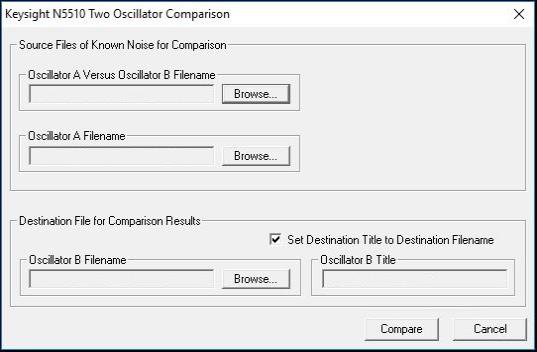
The images used below are interchangeable for the N5510 and E5500 phase noise test system software.
The three-source comparison measurement determines the phase noise level for each of three similar sources. This measurement is useful when the combined reference and DUT noise approaches or exceeds specification, making it unclear if the DUT by itself passes or not. The three-source comparison computes the noise level of three separate sources by measuring them in pairs (A vs. B, A vs. C, and B vs. C). The phase noise test system software stores the computed noise level for each of the three sources in separate result files.
Once results are obtained using the three-source comparison procedure, any of these three sources can then be used as the reference source of a two-source comparison measurement if the key test parameters remain the same. The test system subtracts the noise level of the reference source from the overall measurement to obtain the noise contribution of the DUT.
Normally the two-source comparison procedure is used when measuring phase noise as it does not require any additional setups or measurements—only an additional analysis step using existing characterization data. The three-source comparison procedure is only used:
The phase noise of the three sources should be within 6 dB of each other.
The sum of the phase noise of the two quieter sources must equal or exceed the phase noise of the noisiest device.
The three sets of measurements (A vs. B, A vs. C, and B vs. C) must use the same test conditions.
A minimum of 20 measurement averages must be used.
|
|
The images used below are interchangeable for the N5510 and E5500 phase noise test system software. |
Configure the phase noise test system with source A as your reference source and let source B be the DUT.
Define the phase noise measurement and perform a measurement. Under the Define Measurement pull down, ensure the tab Type and Range has the FFT Analyzer Minimum Number of Averages set to 20.
Store the results to a file for later use. (These will be the 'A vs. B' results.)
Substitute source C in place of source B.
Using the same phase noise definition as in step 2, perform a new measurement and store the results to a file for later use. (These will be the 'A vs. C' results.)
Replace the reference source A with source B.
Repeat step 5. (The results stored will be the 'B vs. C' results.)
In the phase noise test system Users Interface, select the Analyze pull-down menu and click on 3
Oscillator Comparison. The following panel is displayed:
Click on Browse... and find the file saved in step 3 for A vs. B.
Repeat step 9 and browse for the A vs. C and B vs. C files.
In the lower section of the panel, select where you want the comparison results to be saved.
Click Compare.
Open the file of the source corresponding to the DUT and compare these results to the DUT's specifications.
Perform a phase noise measurement using the same test parameters as when the reference source was characterized using the three-source comparison procedure. Store this file.
In the phase noise test system User Interface, select the Analyze pull-down menu and
click on Oscillator Comparison. The following panel is displayed:
In the field for Oscillator A Versus Oscillator B Filename, browse and enter the full filename for the phase noise measurement stored in step 1.
In the field for Oscillator A Filename, browse and enter the full filename of the characterization file for the reference source computed using the three-source comparison procedure. (This will be one of the destination filenames defined in step 11 of the three-source comparison procedure. NOTE: the characterization data should be re-generated if it is older than one year.)
In the field for Oscillator B Filename, browse and enter the full filename for where the measurement results for the DUT will be stored.
Click Compare.
Open the file defined in step 6 and compare these results to the DUT's specifications.
If the DUT fails to meet specifications, a full three-source comparison procedure should be performed to verify that nothing has changed since the original characterization data was measured and to ensure that it is a true failure.
